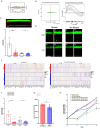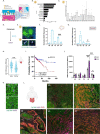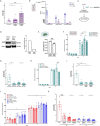This is a preprint.
Integration of Patient-Derived Organoids and Organ-on-Chip Systems: Investigating Colorectal Cancer Invasion within the Mechanical and GABAergic Tumor Microenvironment
- PMID: 37745376
- PMCID: PMC10515884
- DOI: 10.1101/2023.09.14.557797
Integration of Patient-Derived Organoids and Organ-on-Chip Systems: Investigating Colorectal Cancer Invasion within the Mechanical and GABAergic Tumor Microenvironment
Abstract
Three-dimensional (3D) in vitro models are essential in cancer research, but they often neglect physical forces. In our study, we combined patient-derived tumor organoids with a microfluidic organ-on-chip system to investigate colorectal cancer (CRC) invasion in the tumor microenvironment (TME). This allowed us to create patient-specific tumor models and assess the impact of physical forces on cancer biology. Our findings showed that the organoid-on-chip models more closely resembled patient tumors at the transcriptional level, surpassing organoids alone. Using 'omics' methods and live-cell imaging, we observed heightened responsiveness of KRAS mutant tumors to TME mechanical forces. These tumors also utilized the γ-aminobutyric acid (GABA) neurotransmitter as an energy source, increasing their invasiveness. This bioengineered model holds promise for advancing our understanding of cancer progression and improving CRC treatments.
Keywords: invasion; neurotransmitters; organoids; organs-on-chips; peristalsis.
Conflict of interest statement
DECLARATION OF INTEREST The authors declare no competing interest.
Figures





Similar articles
-
Immunotherapy discovery on tumor organoid-on-a-chip platforms that recapitulate the tumor microenvironment.Adv Drug Deliv Rev. 2022 Aug;187:114365. doi: 10.1016/j.addr.2022.114365. Epub 2022 Jun 3. Adv Drug Deliv Rev. 2022. PMID: 35667465 Review.
-
Enabling peristalsis of human colon tumor organoids on microfluidic chips.Biofabrication. 2021 Oct 25;14(1). doi: 10.1088/1758-5090/ac2ef9. Biofabrication. 2021. PMID: 34638112
-
Dendritic cell phenotype and function in a 3D co-culture model of patient-derived metastatic colorectal cancer organoids.Front Immunol. 2023 Jan 25;14:1105244. doi: 10.3389/fimmu.2023.1105244. eCollection 2023. Front Immunol. 2023. PMID: 36761758 Free PMC article.
-
Engineering Vascularized Organoid-on-a-Chip Models.Annu Rev Biomed Eng. 2021 Jul 13;23:141-167. doi: 10.1146/annurev-bioeng-090120-094330. Epub 2021 Mar 23. Annu Rev Biomed Eng. 2021. PMID: 33756087
-
Microphysiological systems to study colorectal cancer: state-of-the-art.Biofabrication. 2023 Apr 5;15(3). doi: 10.1088/1758-5090/acc279. Biofabrication. 2023. PMID: 36888998 Review.
References
-
- Wakefield L., Agarwal S. & Tanner K. Preclinical models for drug discovery for metastatic disease. Cell 186, 1792–1813 (2023). - PubMed
Publication types
Grants and funding
LinkOut - more resources
Full Text Sources
Miscellaneous
